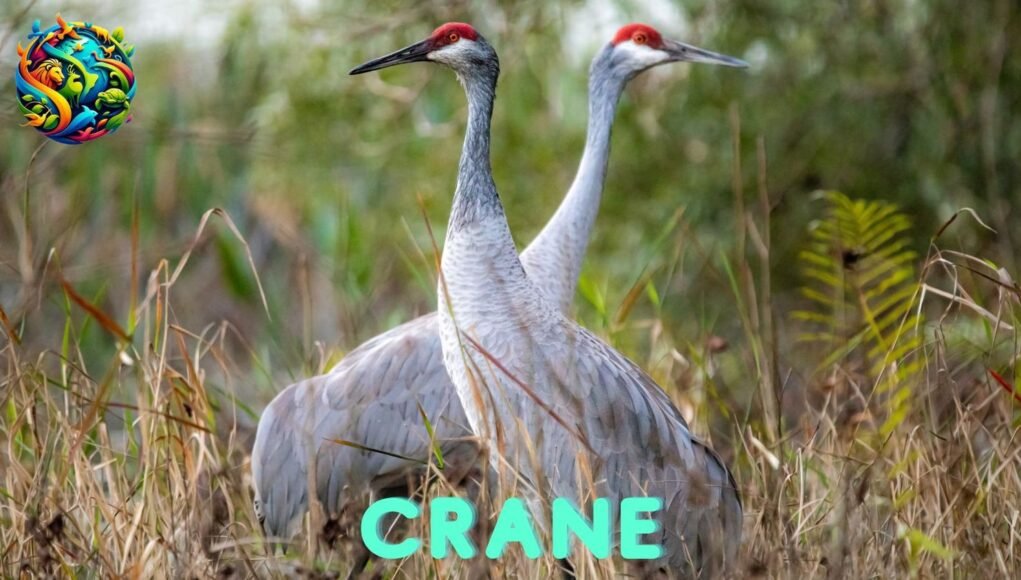Introduction
The majestic crane, a large wading bird revered for its elegance and grace, captivates observers with its striking appearance and enchanting behavior. Found across continents, from the vast wetlands of North America to the remote marshes of Asia, these stunning birds migrate thousands of miles each year, embodying resilience and endurance. Humans often relate to cranes as symbols of hope, fidelity, and longevity in various cultures, drawing inspiration from their graceful flight and harmonious calls.
Incredible Facts about Crane
- These long-legged birds exhibit remarkable longevity, with some individuals living up to 30 years in the wild!
- The migrating waterfowl species engage in spectacular courtship dances involving intricate steps and synchronized movements that can last for hours.
- The world is home to 15 different species of these wading birds, each uniquely adapted to their environments, leading to fascinating differences in behavior and appearance.
- Some of these tall avians can fly at altitudes exceeding 10,000 feet, showcasing incredible stamina and navigational abilities during migration.
Physical Traits & Adaptations
One striking feature of these wetland dwellers is their elongated neck, which allows easy foraging in shallow waters and marshes where they find their primary diet of aquatic plants, small fish, and invertebrates. This adaptation not only aids in feeding but also plays a role in their captivating courtship displays, where they use their long necks to perform graceful, synchronized movements with their partners.
Additionally, the vibrant plumage of many tall waterfowl serves a dual purpose. For instance, the striking red and white colors of the crane bird habitat, such as the Sandhill Crane, are not just for attraction but also function in communication, helping these birds convey signals to one another in both mating rituals and social interactions.
Finally, these elegant species exhibit a unique habit of nesting in elevated areas within their wetlands. This reflects an evolutionary adaptation to avoid predation from terrestrial animals, ensuring the safety of their young. By choosing these strategic locations, the tall birds significantly increase the chances of their chicks surviving to adulthood.
In every flap of their wings as they soar across the skies, cranes remind us of the delicate balance of life, echoing the timeless dance of nature itself.
Habitat and Wetland Ecosystem
Natural Range
These long-legged waders can be found across a diverse array of regions, thriving in various ecosystems that offer the right combination of wetland areas, grasslands, and open fields. From the ancient marshes of East Africa to the expansive boreal forests of Siberia, these magnificent birds have adapted to a multitude of environments.
One particularly notable region is the Platte River in Nebraska, USA, which serves as a critical stopover point during their spring migration. Here, vast stretches of shallow water and mudflats provide an ideal habitat for these birds, enabling them to refuel and prepare for their long journeys. The interplay between ecology and behavior creates dazzling group displays and synchronized movements, painting a captivating picture of nature in action.
Climate and Adaptation
These tall avians require habitats that support not only their migratory needs but also reproductive and feeding behaviors. They are sensitive to climatic conditions, which greatly influence habitat choices. In temperate regions, cranes migrate to warmer areas during winter and return to breeding grounds during warmer months.
Their adaptability is evident in their mating rituals, often performed in pairs or small groups in open spaces that allow for visual communication. During breeding season, a return to wetlands is essential, as these areas are critical for nesting—each nest being a mound of vegetation positioned near water to protect fledglings from predators. Their coexistence with other species in these environments contributes to biodiversity, making these wetlands vibrant ecosystems.
Diet and Feeding Behavior
The diet of these tall birds varies by habitat but generally consists of grains, seeds, tubers, and small invertebrates. In wetland areas, they can often be seen foraging for aquatic plants and insects among marshy terrain. With their long legs and sharp bills, these waterfowl are adept at probing the ground for hidden snacks, creating an industrious scene as they shuffle through wet grasses and muddy patches.
Their feeding behavior also reflects complex social structures. These birds often feed in family groups or flocks, creating a sense of community and allowing juvenile members to learn vital foraging skills from their parents. The ability to locate food efficiently underscores their ecological role as both consumers and as contributors to the vegetative balance of their habitats.
Predators and Threats
In the Wild
While cranes are large and formidable, they still face threats from various predators. Raptor species, such as eagles and hawks, see young chicks as prey, while ground predators like foxes and coyotes pose a risk to nesting birds. Their instinct to remain vigilant, often gathering in numbers for protection, helps mitigate these risks. Their strong pair bonds and social behaviors enable them to ensure the safety of their young.
Human Impact
Human activities pose significant challenges to crane populations through habitat destruction, pollution, and agricultural expansion. Wetlands and grasslands are often drained for development, reducing available foraging and nesting grounds. Additionally, pesticides threaten their food sources and health. Migration routes are impacted by climate change and habitat fragmentation, making it harder for these tall birds to find suitable habitats. The loss of these environments emphasizes the adaptations they must make to survive in an ever-changing landscape.
Conservation Efforts
Conservation initiatives play a crucial role in protecting these graceful species and their habitats. Organizations and governments are restoring wetlands and creating safe environments for these birds. Protected areas, such as the Rhinoceros and Crane Sanctuary in China, offer refuge for endangered species, while community programs teach coexistence and sustainable practices. These measures aim to preserve the delicate ecological balance these magnificent creatures depend on.
Species and Classifications
The world of these wading birds is rich and diverse, with around 15 species spread across the globe, each showcasing unique traits and adaptations. One of the most well-known species is the Grus americana, commonly referred to as the Whooping Crane. This majestic bird, with its distinct white feathers and striking red crown, is an endangered species, historically reduced to just 15 individuals in the 1940s. Conservation efforts have brought their numbers back to over 600, but they remain a symbol of resilience amidst the threat of extinction.
Another notable species is the Grus japonensis, or the Siberian Crane. Recognizable by its long neck and black crowns, it undertakes one of the longest migrations of any large bird, traveling from northeastern Siberia to warmer regions in East Asia. In contrast, the Antigone canadensis, or Sandhill Crane, is more adaptable, thriving in wetlands and agricultural fields alike. They are known for their distinctive bugling calls that echo over vast distances.
Mating, Family, and Communication
These elegant birds are remarkable not only for their grace but also for their intricate social and breeding behaviors. During courtship, they engage in elaborate displays involving dance-like movements that showcase agility and bonding. These performances include synchronized jumps and bows, strengthening pair bonds and reflecting trust.
Once paired, often for life, they create family units that are equally engaging. In species like the Sandhill Crane, both parents share responsibility for raising their young. Adults take turns guarding the nest and leading their chicks to foraging grounds. A memorable anecdote illustrates this beautifully: in a national park in Nebraska, a ranger observed a pair tirelessly teaching their chicks how to find food. The parents demonstrated their foraging techniques, while the chicks eagerly mimicked, pecking the ground in excitement.
Communication plays a vital role within their family groups. Their calls echo across wetlands and grasslands to maintain contact. When young are separated, a soft call from the adult prompts a distinct chirp from the chick, ensuring they reunite quickly. This bond demonstrates not only intelligence but adaptability, as they modify calls to suit their habitat.
Humans and Crane
These majestic birds have long held symbolic value across cultures, representing loyalty, grace, and peace. In Japan, the crane symbolizes good fortune and longevity. The story of the thousand origami cranes, born after World War II, remains a testament to hope and healing. In art and literature, cranes serve as metaphors for love and fidelity, often portrayed as serene figures in traditional paintings.
Pronunciation in Major Languages
- English – crane
- Spanish – grulla
- French – grue
- German – Kranich
The appeal of these graceful waders transcends borders and languages, uniting people in admiration of their beauty. As ecological marvels and cultural icons, cranes inspire stories that connect us to the natural world, reminding us of the balance we must maintain to protect them for generations to come.
FAQs
What is a crane used for?
A crane is typically used for lifting and moving heavy objects, especially in construction and industrial settings. They can transport materials like steel and concrete, making tasks easier and safer.
What are the different types of cranes?
There are several types of cranes, including tower cranes, mobile cranes, and overhead cranes, each designed for specific tasks. For instance, tower cranes are commonly found at construction sites, while mobile cranes offer more flexibility for various jobs.
How does a crane operate?
Cranes operate using pulleys and cables that allow a hoisting mechanism to lift and lower loads. Operators control the crane’s movements precisely to ensure safety and efficiency during operations.
What safety measures are in place for crane operations?
Safety measures include regular maintenance checks, operator training, and adherence to safety regulations. These precautions help prevent accidents and ensure smooth operation.
Can anyone operate a crane?
No, operating a crane requires specialized training and certification, ensuring operators understand the machinery and safety protocols. This helps mitigate risks and ensures cranes are used safely and effectively.
Learn more on Wikipedia.





Very interesting topic, thankyou for putting up. “Stranger in a strange country.” by Sophocles.
This resource is designed to help you discover new movies.Every collection contains movie posters, preview trailers, and direct streaming access,and the collections are organized by themes and categories.The platform is continuously maintained with new releases.This approach streamlines your search by bringing together all necessary elements.You can access this content easily.